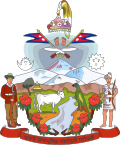King of Nepal
| King ofNepal | |
|---|---|
| Mahārājdhirāj | |
 Royal Coat of arms(before 2006) | |
 | |
| Details | |
| Style | His Majesty |
| First monarch | Prithvi Narayan Shah |
| Last monarch | Gyanendra Bir Bikram Shah |
| Formation | 25 September 1768 |
| Abolition | 28 May 2008 |
| Residence | Narayanhiti Palace,Kathmandu |
| Appointer | Hereditary |
| Pretender(s) | Gyanendra Bir Bikram Shah |
TheKing of Nepal(traditionally known as theMahārājdhirājai.e. Great King of Kings;Nepali:महाराजधिराज) wasNepal'shead of stateandmonarchfrom 1768 to 2008. He served as the head of the Nepalese monarchy—ShahDynasty. The monarchy was abolished on 28 May 2008 by the1st Constituent Assembly.[1]Thesubnational monarchiesinMustang,Bajhang,Salyan,andJajarkotwere abolished in October of the same year.[2]
History
[edit]The Kingdom of Nepal was founded on 25 September 1768 byPrithvi Narayan Shah,aGorkhaking who succeeded inunifyingthe kingdoms ofKathmandu,Patan,andBhaktapurinto a single state under hisShah dynasty.The Kingdom of Nepal wasde jureanabsolute monarchyfor most of its history. However, from 1846 until the1951 revolution,the country wasde factoruled by the hereditaryprime ministersfrom theRana dynasty,reducing the role of the Shah monarch to that of afigurehead.In November 1990, after theJana Andolanmovement, a newconstitutionwas adopted and the country became aconstitutional monarchy.
Nepalese Civil War
[edit]On 13 February 1996, theNepalese Civil Warwas launched by theCommunist Party of Nepal (Maoist),with the aim of overthrowing the kingdom and establishing a "People's Republic".
Nepalese royal massacre
[edit]On 1 June 2001, nine members of the royal family, includingKing BirendraandQueen Aishwarya,were killed in amass shootingat theroyal residence.Crown PrinceDipendrawas implicated in an official investigation. There is a huge controversy concerning this, as there was no practical investigation on that which proves his involvement. Many Nepali people believe that there might be many other people involved in the massacre.[3]Immediately after the massacre, Dipendra was proclaimed king while in acoma,but he died on 4 June 2001, after a three-day reign.[4]His uncle, PrinceGyanendra,was appointedregentfor the three days, then ascended the throne himself after Dipendra died.
Post-massacre
[edit]On 1 February 2005, as the security situation deteriorated in the civil war, KingGyanendrastaged acoup d'état,declared astate of emergency,suspended the constitution and assumed direct control over the country.[5]On 24 April 2006, after theLoktantra Andolanmovement, the king agreed to give up absolute power and to reinstate the dissolvedHouse of Representatives.[6][7]On 21 November 2006, the civil war was ended with the signing of theComprehensive Peace Accord.[8]On 15 January 2007, the King was suspended from exercising his duties by the newly formedinterim legislature.Finally, on 28 May 2008, the kingdom was officially abolished by the1st Constituent Assemblyand theFederal Democratic Republic of Nepalwas declared.[9]Thesubnational monarchiesinMustang,Bajhang,Salyan,andJajarkotwere also abolished in October 2008.[10]
Note
[edit]Prithvi Narayan Shahwas the first ruler of "unified" Nepal. However, prior to 1768, the modern-day Nepal consisted of various small kingdoms, among which Shah Kings continued to rule in a few of them (notably inGorkha). So the actual history of theShah dynastydates much before Prithvi Narayan Shah.[11]
Royal Standard & Royal Crown
[edit]-
Royal Standard of Nepal (c. 1928)
-
Royal Standard of Nepal (c. 1969)
-
Royal Standard of Nepal (c. 2001)
-
Royal Crown of Nepal,Shripech
See also
[edit]- Coronation of the Nepalese monarch
- List of heads of state of Nepal
- National Defence Army
- Panchayat (Nepal)
- President of Nepal
- Prime Minister of Nepal
- Rastriya Prajatantra Party Nepal
References
[edit]- ^"Nepal votes to abolish monarchy".28 May 2008.Archivedfrom the original on 7 January 2017.Retrieved20 July2009.
- ^"Abolishment of subnational monarchies".Archived fromthe originalon 9 June 2009.Retrieved20 July2009.
- ^"Why Nepal's Crown Prince Went on a Killing Spree | Public Radio International".Archivedfrom the original on 12 February 2020.Retrieved23 August2020.
- ^"Nepal mourns slain king".BBC News. 2 June 2001.Archivedfrom the original on 7 January 2009.Retrieved31 May2009.
- ^Staff writer (1 February 2005)."Nepal's king declares emergency".BBC News.Archivedfrom the original on 30 May 2012.Retrieved29 October2012.
- ^Sengupta, Somini (25 April 2006)."In a Retreat, Nepal's King Says He Will Reinstate Parliament".The New York Times.Archivedfrom the original on 22 December 2017.Retrieved22 February2017.
- ^"Full text: King Gyanendra's speech".BBC. 24 April 2006.Archivedfrom the original on 22 December 2006.Retrieved29 October2012.
- ^"Peace deal ends Nepal's civil war".BBC News. 21 November 2006.Archivedfrom the original on 23 November 2020.Retrieved22 November2006.
- ^"Nepal votes to abolish monarchy".28 May 2008.Archivedfrom the original on 7 January 2017.Retrieved20 July2009.
- ^"Abolishment of subnational monarchies".Archived fromthe originalon 9 June 2009.Retrieved20 July2009.
- ^"The History of Nepal".Archived fromthe originalon 16 August 2009.





